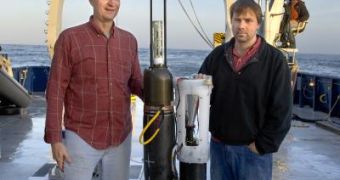Over the past few years, engineers and scientists from several universities and research institutions have argued that geoengineering – as in using artificial substances to change natural feats of the oceans, such as the production of plankton, and also to boost the water's ability to store carbon dioxide – is the best way of deterring global warming, and climate change, implicitly. However, according to a new study, which will appear in a forthcoming issue of the journal Global Biogeochemical Cycles, the scheme may not be nearly as effective as advertised.
In short, experts at the US Department of Energy's (DOE) Lawrence Berkeley National Laboratory (LBNL) have announced that the Iron Hypothesis doesn't work. Simply put, this line of thought holds that, by fertilizing waters with iron particles, in areas where the metal is missing, but other nutrients exist, could directly bring the evolution of global warming to a stand-still, and even stop the phenomenon. Iron helps plankton – the basic life form in the ocean – bloom, and plankton consumes more carbon dioxide from the surface.
When the organisms die, they take all the CO2 they've consumed over their life down to the ocean floor, where it gets trapped. Following this line of reasoning, the more organisms live, the more greenhouse gases get sucked in, and the clearer the atmosphere becomes. But the LBNL team, using data from the Carbon Explorer floats, which are deep-diving sensors, has determined that the effect of ocean fertilization in designated test areas around the Southern Ocean is null, and that the amounts of carbon dioxide have not increased at all.
“Just adding iron to the ocean hasn't been demonstrated as a good plan for storing atmospheric carbon. What counts is the carbon that reaches the deep sea, and a lot of the carbon tied up in plankton blooms appears not to sink very fast or very far,” LBNL Oceanographer Jim Bishop, who is also a University of California in Berkeley (UCB) professor of Earth and Planetary Sciences and a member of the Earth Sciences Division at the Berkeley Laboratory, explains. “We would never have made these surprising observations if the autonomous Carbon Explorer floats hadn't been recording data 24 hours a day, seven days a week, at depths down to 800 meters or more, for over a year after the experiment's original iron signature had disappeared,” he adds.
“Assumptions about the biological pump – the way ocean life circulates carbon – are mostly based on averaging measurements that have been made from ships, at intervals widely separated in time. Cost, not to mention the environment, would have made continuous ship-based observations impossible in this case. Luckily, one Carbon Explorer float costs only about as much as a single day of ship time,” Bishop goes on to explain.
“Iron is not the only factor that determines phytoplankton growth in HNLC regions. Light, mixing, and hungry zooplankton are fundamentally as important as iron. You can grow a lot of Brussels sprouts, but kids won't eat it. The same appears to be the case with diatom phytoplankton and zooplankton. It's the zooplankton community that determines carbon sedimentation,” the expert concludes.

 14 DAY TRIAL //
14 DAY TRIAL //